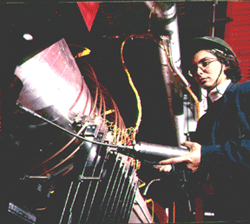
|
|
Rotary KilnThe CANMET Energy Technology Centre Ottawa's pilot-scale rotary kiln is ideally suited for process improvement studies:
Using the rotary kiln (Fig.1), CETC-Ottawa conducts research for its clients to:
Clients are then able to use the results of this work in minimizing operating costs and evaluating their waste disposal and reclamation options. Results are used as decision-making tools to help select fuels and equipment. They are also used to optimize process performances. Data obtained may also serve in the assessment of environmental performance. Features: The rotary kiln at CETC-Ottawa incorporates key design features and environmental safeguards: afterburner, cyclone, baghouse, and wet scrubber. These equipments are standard features in continuously operating commercial plants. The experimental results can be used by clients for scale-up purposes. This, in turn, leads to informed decisions, for example, about process optimization, eg. lime calcinations for the pulp & paper industry, or about the environmental acceptability of using incineration as a means of disposing of residential, industrial or commercial wastes. Capacity and Feeding Rate: CETC-Ottawa's rotary kiln is 4.27m long with an inside diameter of 0.41m and an outside diameter of 0.66m. The material of the inside lining is a high temperature, erosion-resistant, castable refractory that can withstand temperatures up to 1200oC. The kiln is fitted with lifting bars made also from refractory material to expedite continuous movement of the feed through the kiln and to achieve good contact between gas and solids. The speed or rotation is adjustable with in the range from 3 to 6 rpm. Feeding material in the form of solid matter or sludge can be processed at rates of 20 to 200 kg/h. The residence time of the feeds can be varied by changing the rotating speed and the slope of the kiln, or both. Fuel and Burners: The kiln can be fired with natural gas or fuel-oil, or a combination of both and has two burners, one at either end of the reactor. The burners may be operated manually or automatically. Their inputs are 1 MW thermal. Draft in the kiln is controlled by a variable speed ID-fan. The exhaust gas flows counter-current to the feed. The gaseous environment in the kiln can either be oxidizing or reducing; the choice depends on the requirements of the research.
Emission Control: The emission control unit for the CETC-Ottawa rotary kiln include afterburner, multiclone, baghouse, and two-stage wet scrubber. The afterburner unit, with its own two burners and a separate air and fuel control system, is used to achieve complete combustion of volatiles and organics in the flue gas. The flue gas passes from the afterburner to the multiclone and the baghouse where particulates are captured. Sulphur dioxide (SO2) is captured by the two-stage wet srubber through the addition of limestone. Entrained particulates in the flue gas stream can be withdrawn to determine loading, particle sizing, chemical speciation, sulphur retention etc.
Computer Control: The facility is monitored continuously for temperature, pressure, and flue-gas combustion by a dedicated computer. The process is monitored using LabView software by a high-performance, multi- channel signal-conditioning SCXI (Signal Conditioning extensions for Instrumentation) and data acquisition system. Kiln Successfully Pilot-Tested In a project for Environment Canada, the rotary kiln was used to demonstrate that a combustion process could help clean up after oil spills. CETC-Ottawa's scientists and engineers burned oil-soaked debris, which included sorbents and contaminated soil and gravel, in the rotary kiln. Test results confirmed that such type of materials can be easily combusted/incinerated in a rotary kiln. When appropriately designed and under optimal operating conditions, the rotary kiln can be used very successfully for remediation of oil-contaminated sites with minimum operational or emission related problems. In another study for Suncor Inc. and Syncrude Canada Ltd., titanium and zirconium metals were recovered from the combustion of bitumen in flotation concentrates of tar sand tailings. The study also showed that the properties of pyrite, siderite and other minerals could be altered during combustion to increase the quantities of metals reclaimed. CETC-Ottawa Invites Requests for Research The research team operating CETC-Ottawa's rotary kiln welcomes requests for research and investigative studies. It will conduct research on a collaborative, cost-shared or cost-recovery basis. Client confidentiality will be respected. For further information, please contact: Natural Resources Canada |




